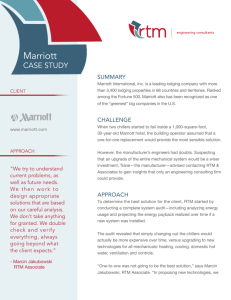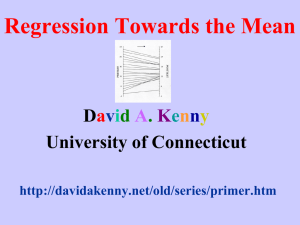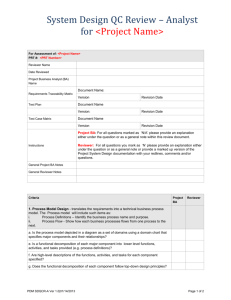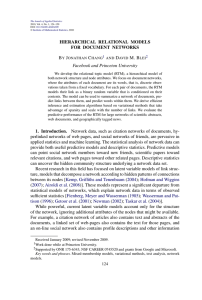LDAnetwork
advertisement
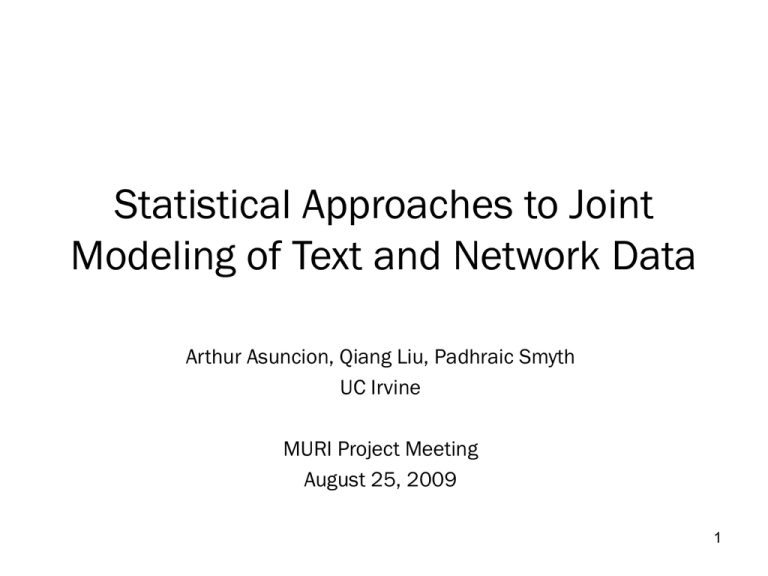
Statistical Approaches to Joint
Modeling of Text and Network Data
Arthur Asuncion, Qiang Liu, Padhraic Smyth
UC Irvine
MURI Project Meeting
August 25, 2009
1
Outline
• Models:
– The “topic model”: Latent Dirichlet Allocation (LDA)
– Relational topic model (RTM)
• Inference techniques:
– Collapsed Gibbs sampling
– Fast collapsed variational inference
– Parameter estimation, approximation of non-edges
• Performance on document networks:
– Citation network of CS research papers
– Wikipedia pages of Netflix movies
– Enron emails
• Discussion:
– RTM’s relationship to latent-space models
– Extensions
2
Motivation
• In (online) social networks, nodes/edges often have
associated text (e.g. blog posts, emails, tweets)
• Topic models are suitable for high-dimensional count data,
such as text or images
• Jointly modeling text and network data can be useful:
– Interpretability: Which “topics” are associated to each node/edge?
– Link prediction and clustering, based on topics
3
What is topic modeling?
• Learning “topics” from a set of documents in a statistical
unsupervised fashion
List of “topics”
“bag-of-words”
Topic Model
Algorithm
# topics
Topical characterization
of each document
• Many useful applications:
–
–
–
–
Improved web searching
Automatic indexing of digital historical archives
Specialized search browsers (e.g. medical applications)
Legal applications (e.g. email forensics)
4
Latent Dirichlet Allocation (LDA)
[Blei, Ng, Jordan, 2003]
• History:
– 1988: Latent Semantic Analysis (LSA)
• Singular Value Decomposition (SVD) of word-document count matrix
– 1999: Probabilistic Latent Semantic Analysis (PLSA)
• Non-negative matrix factorization (NMF) -- version which minimizes KL divergence
– 2003: Latent Dirichlet Allocation (LDA)
• Bayesian version of PLSA
K
D
W
P (word | doc)
≈
W
P (word | topic)
D
*
K
P (topic | doc)
5
Graphical model for LDA
Each document d has a distribution over
topics
Θk,d ~ Dirichlet(α)
Each topic k is a distribution
over words
Φw,k ~ Dirichlet(β)
wk
K
kd
Topic assignments for each word are
drawn from document’s mixture
zid ~ Θk,d
Zid
The specific word is drawn from the topic
zid
X id
Nd
D
• Hidden/observed variables are in unshaded/shaded circles.
• Parameters are in boxes.
• Plates denote replication across indices.
xid ~ Φw,z
Demo
6
What if the corpus has
network structure?
CORA citation network. Figure from [Chang, Blei, AISTATS 2009]
7
Relational Topic Model (RTM)
[Chang, Blei, 2009]
• Same setup as LDA, except now we have observed network information
across documents (adjacency matrix)
“Link probability function”
,
kd
y d, d'
Zid
X id
kd'
Zid'
Nd
wk
Documents with similar topics
are more likely to be linked.
X id'
K
N d’
8
Link probability functions
• Exponential:
• Sigmoid:
• Normal CDF:
• Normal:
– where
0/1 vector
of size K
Element-wise
(Hadamard) product
Note: The formulation above is similar to “cosine distance”, but since we don’t
divide by the magnitude, this is not a true notion of “distance”.
9
Approximate inference techniques
(because exact inference is intractable)
• Collapsed Gibbs sampling (CGS):
– Integrate out Θ and Φ
– Sample each zid from the conditional
– CGS for LDA: [Griffiths, Steyvers, 2004]
• Fast collapsed variational Bayesian inference (“CVB0”):
– Integrate out Θ and Φ
– Update variational distribution for each zid using the conditional
– CVB0 for LDA: [Asuncion, Welling, Smyth, Teh, 2009]
• Other options:
– ML/MAP estimation, non-collapsed GS, non-collapsed VB, etc.
10
Collapsed Gibbs sampling for RTM
• Conditional distribution of each z:
LDA term
“Edge” term
“Non-edge” term
• Using the exponential link probability function, it is computationally
efficient to calculate the “edge” term.
• It is very costly to compute the “non-edge” term exactly.
11
Approximating the non-edges
1.
Assume non-edges are “missing” and ignore the term entirely (Chang/Blei)
2.
Make the following fast approximation:
3.
Subsample non-edges and exactly calculate the term over subset.
4.
Subsample non-edges but instead of recalculating statistics for every zid token,
calculate statistics once per document and cache them over each Gibbs sweep.
12
Variational inference
• Minimize Kullback-Leibler (KL) divergence between true posterior and
“variational” posterior (equivalent to maximizing “evidence lower bound”):
Jensen’s inequality.
Gap = KL [q, p(h|y)]
By maximizing this lower bound, we are implicitly minimizing KL (q, p)
• Typically we use a factorized variational posterior for computational reasons:
13
CVB0 inference for topic models
[Asuncion, Welling, Smyth, Teh, 2009]
• Collapsed Gibbs sampling:
• Collapsed variational inference (0th-order approx):
•“Soft” Gibbs update
• Deterministic
• Very similar to ML/MAP estimation
• Statistics affected by q(zid):
– Counts in LDA term:
– Counts in Hadamard product:
14
Parameter estimation
• We learn the parameters of the link function (γ = [η, ν]) via gradient
ascent:
Step-size
• We learn parameters (α, β) via a fixed-point algorithm [Minka 2000].
– Also possible to Gibbs sample α, β
15
Document networks
# Docs
# Links
Ave. DocLength
Vocab-Size
Link Semantics
CORA
4,000
17,000
1,200
60,000
Paper citation (undirected)
Netflix
Movies
10,000
43,000
640
38,000
Common actor/director
Enron
(Undirected)
1,000
16,000
7,000
55,000
Communication between
person i and person j
Enron
(Directed)
2,000
21,000
3,500
55,000
Email from person i to
person j
16
Link rank
•
•
We use “link rank” on held-out data as our evaluation metric.
Lower is better.
dtest
{dtrain}
Black-box
predictor
Edges among {dtrain}
•
Ranking over {dtrain}
Link ranks
Edges between dtest and {dtrain}
How to compute link rank for RTM:
1.
2.
3.
4.
Run RTM Gibbs sampler on {dtrain} and obtain {Φ, Θtrain, η, ν}
Given Φ, fold in dtest to obtain Θtest
Given {Θtrain, Θtest, η, ν}, calculate probability that dtest would link to each dtrain. Rank
{dtrain} according to these probabilities.
For each observed link between dtest and {dtrain}, find the “rank”, and average all these
ranks to obtain the “link rank”
17
Results on CORA data
Comparison on CORA, K=20
270
250
Link Rank
230
210
190
170
150
Baseline
(TFIDF/Cosine)
LDA + Regression
Ignoring non-edges
Fast approximation of
Subsampling nonnon-edges
edges (20%)+Caching
We performed 8-fold cross-validation. Random guessing gives link rank = 2000.
18
Results on CORA data
650
400
Baseline
RTM, Fast Approximation
350
550
500
Link Rank
300
Link Rank
Baseline
LDA + Regression (K=40)
Ignoring Non-Edges (K=40)
Fast Approximation (K=40)
Subsampling (5%) + Caching (K=40)
600
250
200
450
400
350
300
250
150
200
100
0
20
40
60
80
100
Number of Topics
120
140
160
150
0
0.2
0.4
0.6
Percentage of Words
0.8
1
• Model does better with more topics
• Model does better with more words in each document
19
Timing Results on CORA
CORA, K=20
7000
6000
Time (in seconds)
5000
LDA + Regression
Ignoring Non-Edges
Fast Approximation
Subsampling (5%) + Caching
Subsampling (20%) + Caching
4000
3000
2000
1000
0
1000
1500
3000
2500
2000
Number of Documents
3500
4000
“Subsampling (20%) without caching” not shown since it takes
62,000 seconds for D=1000 and 3,720,150 seconds for D=4000
20
CGS vs. CVB0 inference
CORA, K=40, S=1, Fast Approximation
500
CGS
CVB0
450
Link Rank
400
Total time:
CGS = 5285 seconds
CVB0 = 4191 seconds
350
300
250
CVB0 converges more quickly.
Also, each iteration is faster due to
clumping of data points.
200
150
0
50
100
Iteration
150
200
21
Results on Netflix
NETFLIX, K=20
Random Guessing
Baseline (TF-IDF / Cosine)
5000
541
LDA + Regression
2321
Ignoring Non-Edges
1955
Fast Approximation
2089
(Note K=50: 1256)
Subsampling 5% + Caching
Baseline does very well!
Needs more investigation…
1739
22
Some Netflix topics
POLICE:
[t2] police agent kill gun action escape car film
DISNEY:
[t4] disney film animated movie christmas cat animation story
AMERICAN: [t5] president war american political united states government against
CHINESE: [t6] film kong hong chinese chan wong china link
WESTERN: [t7] western town texas sheriff eastwood west clint genre
SCI-FI:
[t8] earth science space fiction alien bond planet ship
AWARDS: [t9] award film academy nominated won actor actress picture
WAR:
[t20] war soldier army officer captain air military general
FRENCH:
[t21] french film jean france paris fran les link
HINDI:
[t24] film hindi award link india khan indian music
MUSIC:
[t28] album song band music rock live soundtrack record
JAPANESE: [t30] anime japanese manga series english japan retrieved character
BRITISH:
[t31] british play london john shakespeare film production sir
FAMILY:
[t32] love girl mother family father friend school sister
SERIES:
[t35] series television show episode season character episodes original
SPIELBERG:[t36] spielberg steven park joe future marty gremlin jurassic
MEDIEVAL [t37] king island robin treasure princess lost adventure castle
GERMAN: [t38] film german russian von germany language anna soviet
GIBSON:
[t41] max ben danny gibson johnny mad ice mel
MUSICAL: [t42] musical phantom opera song music broadway stage judy
BATTLE:
[t43] power human world attack character battle earth game
MURDER: [t46] death murder kill police killed wife later killer
SPORTS:
[t47] team game player rocky baseball play charlie ruth
KING:
[t48] king henry arthur queen knight anne prince elizabeth
HORROR: [t49] horror film dracula scooby doo vampire blood ghost
23
Some movie examples
•
'Sholay'
–
–
•
‘Cowboy’
–
–
•
Indian film, 45% of words belong to topic 24 (Hindi topic)
Top 5 most probable movie links in training set:
• 'Laawaris‘
• 'Hote Hote Pyaar Ho Gaya‘
• 'Trishul‘
• 'Mr. Natwarlal‘
• 'Rangeela‘
Western film, 25% of words belong to topic 7 (western topic)
Top 5 most probable movie links in training set:
• 'Tall in the Saddle‘
• 'The Indian Fighter'
• 'Dakota'
• 'The Train Robbers'
• 'A Lady Takes a Chance‘
‘Rocky II’
–
–
Boxing film, 40% of words belong to topic 47 (sports topic)
Top 5 most probable movie links in training set:
• 'Bull Durham‘
• '2003 World Series‘
• 'Bowfinger‘
• 'Rocky V‘
• 'Rocky IV'
24
Directed vs. Undirected RTM on
ENRON emails
ENRON, S=2
180
Undirected RTM
Directed RTM
170
Link Rank
160
•
Undirected: Aggregate incoming & outgoing emails
into 1 document
•
Directed: Aggregate incoming emails into 1
“receiver” document and outgoing emails into 1
“sender” document
•
Directed RTM performs better than undirected RTM
150
140
130
120
10
20
30
40
K
Random guessing: link rank=500
25
Discussion
• RTM is similar to latent space models:
Projection model
[Hoff, Raftery, Handcock, 2002]
Multiplicative latent factor model
[Hoff, 2006]
RTM
• Topic mixtures (the “topic space”) can be combined with the other dimensions
(the “social space”) to create a combined latent position z.
• Other extensions:
– Include other attributes in the link probability (e.g. timestamp of email, language of movie)
– Use non-parametric prior over dimensionality of latent space (e.g. use Dirichlet processes)
– Place a hierarchy over {θd} to learn clusters of documents – similar to latent position
cluster model [Handcock, Raftery, Tantrum, 2007]
26
Conclusion
• Relational topic modeling provides a useful start for combining text
and network data in a single statistical framework
• RTM can improve over simpler approaches for link prediction
• Opportunities for future work:
– Faster algorithms for larger data sets
– Better understanding of non-edge modeling
– Extended models
27
Thank you!
28



